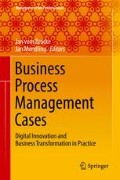Abstract
-
(a)
Situation faced: In order to produce innovative solutions faster and more simply, SAP started in 2008 to transform its research and development processes. SAP moved away from complex and static project methods toward agile and simple processes, thereby significantly reducing the throughput time of the standard innovation cycle. Based on the experience of this transformation and optimization, the first at that time in a global company of knowledge workers, SAP decided to increase the emphasis on Business Process Management (BPM). Therefore, BPM initiatives were implemented on a company-wide level in the effort to establish a process infrastructure and a process improvement culture.
-
(b)
Action taken: The Productivity Consulting Group (PCG) was founded with the mission of strengthening the importance of BPM throughout the company. The SAP Process Map was established to create transparency in SAP’s key processes, roles, and responsibilities. The SAP Process Maturity Model was created with the aim of constantly increasing the maturity of SAP’s processes. An approach to performance measurement and process improvement and a portfolio of BPM-related services were introduced to support Process Managers on their way to reaching process excellence. In addition, activities were introduced to strengthen the BPM community, the foundation for BPM at SAP.
-
(c)
Results achieved: Implementing BPM at SAP was an important step toward overcoming the complexities that plague our businesses, a step that was important to both SAP and its customers. Following the operating principle “Run Simple,” SAP developed a process-management infrastructure throughout the company that led to transparency in SAP’s key processes and measurable process improvements.
-
(d)
Lessons learned: The key success factor in SAP’s journey from BPM concepts and ideas to measurable impact—that is, from paper to impact—was the strategic alignment of BPM with top management support. Strong governance with the SAP Process Map, the SAP Process Maturity Model, and BPM standards enabled the company to strive toward process excellence.
However, a lively and engaged BPM community was as important as having the right methods or tools at hand. Implementing BPM from a top-down perspective helped to some extent, but building an understanding of BPM and its value from the bottom-up using a variety of mechanisms (introduced in this article) was also required.
Access this chapter
Tax calculation will be finalised at checkout
Purchases are for personal use only
References
CMMI Product Team. (2002). Capability maturity model® integration (CMMI), Version 1.1 – continuous representation.
Dumas, M., La Rosa, M., Mendling, J., & Reijers, H. (2013). Fundamentals of business process management. Berlin: Springer.
Mendling, J., Reijers, H. A., & van der Aalst, W. M. (2010). Seven process modeling guidelines (7PMG). Information and Software Technology, 52(2), 127–136.
Rosemann, M., & vom Brocke, J. (2015). Six core elements of business process management. In J. vom Brocke & M. Rosemann (Eds.), Handbook on business process management: Introduction, methods, and information systems (Vol. 1, 2nd ed., pp. 105–122). Berlin: Springer.
SAP Global Corporate Affairs. (2016). SAP corporate fact sheet. Retrieved April 13, from http://www.sap.com/bin/sapcom/en_us/downloadasset.2015-04apr21-01.SAP-Corporate-Fact-Sheet-en-20150421-pdf.bypassReg.html
SAP Process Governance Team, & Konhaeuser, M. (2015, April). SAP process excellence handbook.
SAP SE. (2016). Company information. Retrieved April 13, from http://go.sap.com/corporate/en/company.html
vom Brocke, J., Zelt, S., & Schmiedel, T. (2016). On the role of context in business process management. International Journal of Information Management, 36(3), 486–495.
Author information
Authors and Affiliations
Corresponding author
Editor information
Editors and Affiliations
Rights and permissions
Copyright information
© 2018 Springer International Publishing AG
About this chapter
Cite this chapter
Reisert, C., Zelt, S., Wacker, J. (2018). How to Move from Paper to Impact in Business Process Management: The Journey of SAP. In: vom Brocke, J., Mendling, J. (eds) Business Process Management Cases. Management for Professionals. Springer, Cham. https://doi.org/10.1007/978-3-319-58307-5_2
Download citation
DOI: https://doi.org/10.1007/978-3-319-58307-5_2
Published:
Publisher Name: Springer, Cham
Print ISBN: 978-3-319-58306-8
Online ISBN: 978-3-319-58307-5
eBook Packages: Business and ManagementBusiness and Management (R0)

